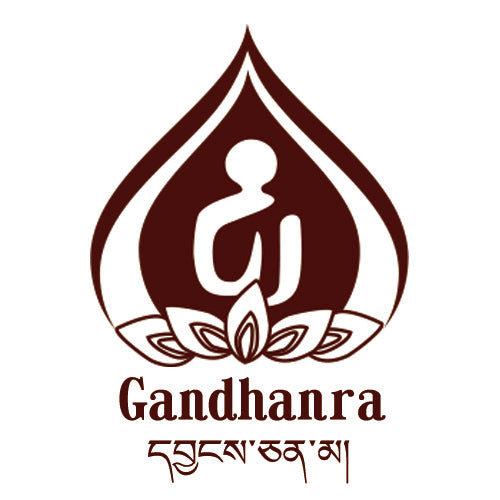
Yellow in Himalayan art: Between the Sun and the Earth

"Rongsang Qujisangbo", 17th century, Royal Ontario Museum
Rongzom Chokyi Zangpo
(1012-1088/1131)
This controversial Nyingma translator and philosopher
was often accompanied by golden light in his dreams
Throughout most of his life
Yellow symbolizes "translational wisdom"
and embodies the identity of a Buddhist scripture translator.

Local
In the biography, the yellow aura is referred to as "the golden light of speech".
(སྒྲ་ཡི་སེར་འོད་)

"Bodhisattva," 14th century, Rubin Museum of Art
Among the "Five Buddhas," the Amitabha Buddha is located in the south,
and his body color is golden yellow.
The Sakya tradition founder refers to it as the "color of the sun"(ཉི་མའི་ཁ་མདོག་),
emphasizing its significance in representing the wisdom of equality.

Local
The term "sunshine yellow" refers to a pale yellow color, similar to the color of a goose or milk. It can also refer to a darker shade of yellow in general.

"The Goddess of Wealth and the monk from Han Dynasty", 17th century, Ruben Museum
The above combination is not commonly seen
Usually associated with the "expansion" aspect of the "four industries"
Yellow is the symbol color for "expansion"

Local: Cai Yuan Tian Mu
As a female deity of both spiritual practice and wealth,
the worship of the Goddess of Wealth can be traced back to
early South Asian local goddesses,
yellow-bodied "Prosperity" deities
empowering karmic consequences and their worldly forms
(such as wealth and health, etc.)

Local: Fortune Peach
The color of the peach in the hands of the monk from Han region changes continually with different scenery.
A yellow peach is called an "unripe yellow peach"(མ་སྨིན་ཁམ་སེར་).
It symbolizes the continuous increase of good deeds.

Local: Corner of Offerings
Yellow-white is the most common color of offerings.
White symbolizes basic offerings,
while yellow symbolizes special offerings,
such as golden altar offerings.

Local
Pink (དམར་སྐྱ་) is the color of "nuns,"
while orange (ལི་ཁྲི་ཚོན་) is the color of "monks,"
"Monks" and "nuns" should not be too close,
They need to be separated by the colors of the sky and earth (blue/green/white)

"The Yellow Zhanbala," 20th century, Tibet House Museum
Store fine wine in conch shells
The ferret and fruits in hand symbolize wealth
The Yellow Jambhala is among the "increase" gods
The most popular practice deity in Tibetan Buddhism
དམར་སེར་གཉིས་པོ་ཚོན་གྱི་བླ་མ་ཡིན།
བཀྲག་གདངས་འདོད་ན་དེ་ཡི་ནང་ལ་ཡོད།
Red and yellow as colors represent high lamas.
If brightness is added, then red and yellow.
(Tibetan painting realm proverb)
* (The New/Classic) Miantang School believes that "red and yellow" can symbolize monks
In color theory, it also adds a sense of oppression to the artwork.
སེར་པོ་རབ་བྱུང་སྐུ་རགས་དང།
སྟོད་གཡོགས་བེར་ཕྱི་དག་ལ་དབང།
མཚལ་དང་དམར་སེར་རིགས་ཆགས་ཀུན།
ཆོས་གོས་གཟན་ཤམ་ལ་དབང་བ།
Monk's belt, robe, and cloak
The main color is yellow
While the monk's robe and skirt
Are mostly red and red-yellow in color
Demagexi Danzeng Pengcuo
དེའུ་དམར་དགེ་བཤེས་བསྟན་འཛིན་ཕུན་ཚོགས་
(1672-?)
In the traditional painting of Tibet, yellow is the most abundant secondary color.
Yellow is a symbol of nobility and imagination.
- David Jackson
Yellow is warm because the places where the sun shines are all "golden" (མདོག་གསེར་ཕྲེང་; in Tibetan culture, the moon is the collector of the sun's "golden threads"). Yellow is also secretive because it can symbolize divine wisdom and power succession, as well as generic decoration. In local culture, yellow is a regulating color (the color of the goddess in local religion), a decorative color (the color of the master of all decoration materials), and a color used to wrap sacred objects.

Local: Wisdom is the good mother(ཤེས་རབ་བྱམས་མ་)
The Mother of All Deities in indigenous religion
and the fundamental source of cosmic wisdom
She is renowned as the Cosmic Queen(སྲིད་པའི་རྒྱལ་མོ་).
With the influx of color concepts from all directions into the Himalayas and Tibet, the meaning of yellow has also become more complex. In local color theory, Tibetan numerals "five" (༥), "seven" (༧), and "eight" (༨) are often used to represent yellow, orange, and gold; or Tibetan abbreviations "Sa" (ས་) and "La" (ལ་) are used to represent yellow and orange.
Yellow is a commonly used complementary color in Tibetan color theory, so it plays an important role in "color relationships". When "white and yellow" meet, they are like "good friends", adding brilliance to the image; when "black and yellow" meet, they are like "distant relatives", reducing color change; when "green and yellow" meet, they are like "patients", disrupting the color hierarchy; and when yellow colors meet each other, it is considered "so-so", showing a lack of skill on the part of the artist (early Karma Gadri painting schools often used the interaction of yellow colors to test the skills of the artist).

"The Dense Kong" , 17th Century, Rubin Museum
Both the "hook gold method" and "fill gold method" emphasize the importance of yellow as one of the four core background colors.

"Master Tsongkhapa", 18th century, Rubin Museum of Art
In Gelugpa Buddhism, the "Maitreya worship" exalts the sacred significance of yellow to the extreme.

Local

"The Great Achiever Naropa," 18th century, Rubin Museum
Masterpiece of yellow-themed outfit
It is considered to be a work of possibly the "Gustav Klimt of fashion"

Shelter from the golden land

